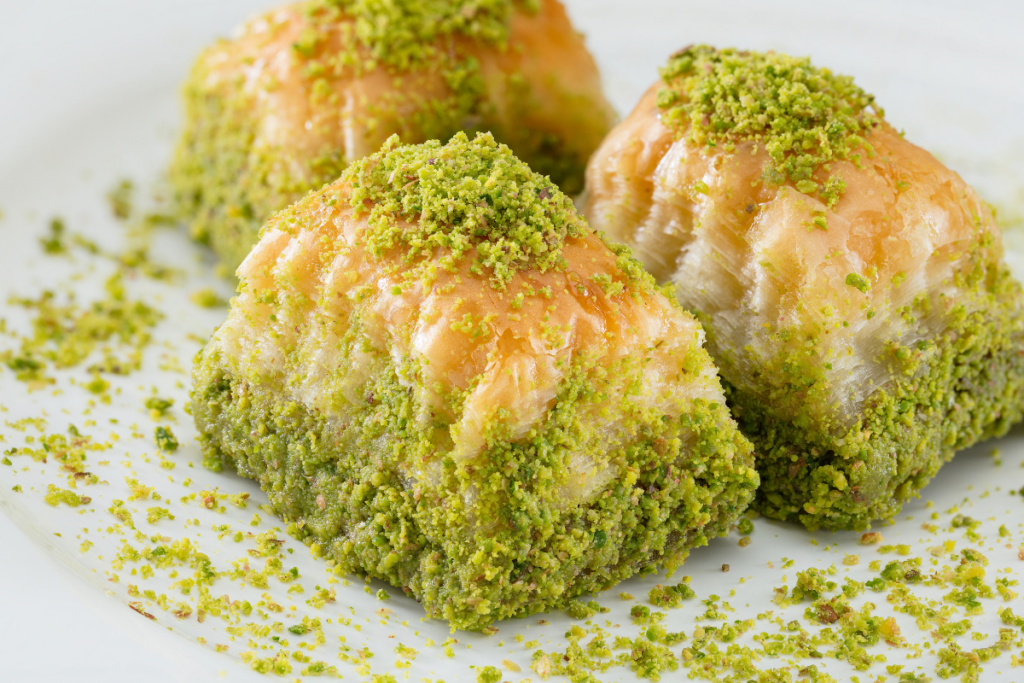Baklava, a dessert originating from Turkey and Greece, stands out as a wonder that has pleased taste buds, for ages. This sugary layered pastry is crafted from phyllo dough sheets, an assortment of nuts, and a sweet syrup, offering a mix of flavors and textures. Apart from its flavor profile, baklava carries a past that mirrors the cultural and culinary traditions of its places of origin.
The History Behind Baklava
The precise origins of baklava remain a topic of discussion, with claims to its creation made by both Turkey and Greece. Some historians attribute its beginnings to the Assyrians, who are thought to have devised a version of this desert around the 8th century B.C. They combined bread with nuts and honey like present-day.
The journey of baklava extended through the Byzantine Empire. Later, the Ottoman Empire played a role in refining the recipe. The Ottomans introduced dough, an intricate dough that now defines baklava. This progression, in ingredients and methods, led to the development of today’s baklava, a dessert that serves as both a representation of heritage and a beloved indulgence worldwide.
Baklava Recipe: Easy to Follow Instructions

Making at home might seem like a challenge. With patience and attention to detail, you can create this delightful pastry.
Here is a simple guide to help you make your baklava.
Ingredients For the Baklava:
- 1 box of dough (16 oz) thawed
- 2 cups of nuts (walnuts, pistachios, almonds) finely chopped
- 1 cup of melted unsalted butter
- 1 teaspoon of cinnamon powder
For the Syrup:
- 1 cup of water
- 1 cup of granulated sugar
- 1 cup of honey
- 1 teaspoon of vanilla extract
Optional: 1/2 teaspoon of ground cloves
A strip of lemon peel
Instructions
Step 1: Prepare the Nut Mixture
Combine the finely chopped nuts with cinnamon in a bowl. Set it aside.
Step 2: Prep the Phyllo Dough
Preheat your oven to 350°F (175°C).
Use some melted butter to grease a baking dish measuring, about 9×13 inches.
Carefully unwrap the dough. Trim it as needed to fit into the baking dish. Cover it with a cloth to prevent drying out.
Step 3: Putting the Baklava
Start by placing a layer of dough, in the baking dish and generously brushing it with melted butter. Repeat this procedure for 7 sheets, making sure to brush each sheet with butter.
Sprinkle a coating of the nut mixture over approximately 3 to 4 tablespoons).
Layer another 5 sheets of phyllo ensuring to brush each sheet with butter.
Repeat the nut layer then add 5 layers of phyllo and butter. Continue this process until all the nuts have been used.
Complete the assembly with 8 to 10 layers of dough, each one brushed with butter.
Step 4: Slicing and Baking the Baklava
Using a knife, cut the baklava into diamond or square shapes.
Bake in the preheated oven for 45 to 50 minutes. Until the baklava achieves a golden-brown hue and turns crispy.
Step 5: Crafting the Syrup
As the baklava bakes, combine water and sugar in a saucepan, overheat.
Bring it to a boil and heat to simmer gently for around 10 minutes.
Incorporate honey vanilla extract, ground cloves (if desired) and lemon zest. Simmer for 10 minutes, before removing from heat. Discard the lemon peel.
After baking, take it out of the oven. Drizzle the syrup, over it immediately, ensuring that all pieces are well covered. Let the baklava cool down completely without covering it to avoid sogginess.
To enjoy and store the baklava
Serving: Once cooled, use a knife to cut along the marked lines and serve at room temperature for the best taste.
Storage: You can keep the baklava at room temperature for up to a week by covering it with a cloth. For storage, refrigerate it. Remember to bring it back to room temperature before serving for optimal flavor and texture.
Baklava represents more than a dessert, it embodies exchange and evolution. Every bite of its crispy layers and nutty filling takes you on a journey through history, from civilizations to modern tables. Whether savored on occasion or as a delight, baklava stands as a timeless tribute, to the rich traditions of Turkish and Greek cuisine.
What next:
- Crocodile Ice Cream: A Wild Adventure in Dessert-Making
- Pasta Carbonara- A Classic Italian Delight
- Japanese Miso Glazed Salmon – A Delicious Taste and Health
- Feijoada – A Taste of Brazil
- Bouillabaisse – The Legendary Fish Stew, from Marseille


